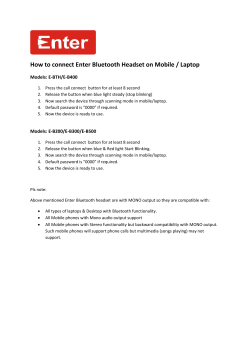
Document 440294
PRE/POWER AMPLIFIER Preamp and mono power amplifier. Rated at 100W/8ohm Made by: Exposure Electronics, Lancing, UK Supplied by: Exposure Electronics Telephone: 01273 423877 Web: www.exposurehifi.com Prices: £940 (pre) / £860 (power, each) Exposure 3010S2 Pre/Mono Exposure’s 3010S2 range is topped by a preampliƂer and pair of monoblock power ampliƂers. Are they a worthwhile upgrade over their integrated ampliƂer stablemate? Review: Adam Smith Lab: Paul Miller t’s a well established upgrade path. You begin with an integrated ampliƂer, progress to a pre/power set-up and then, if money and rack space allow, move up to a pair of monoblocks. Several manufacturers still see this as an extremely effective way of marketing components. One such company is Exposure and its 3010S2 series offers the full range of integrated ampliƂer and preampliƂer, plus both stereo and mono power ampliƂers. I A HOUSE STYLE In typical Exposure style, its preampliƂer, which costs £940, has a neat and subtle look, not immediately distinguishable from that of its integrated sibling. In fact the only visual clue is that the preamp is slightly shorter than the integrated, lending it a sleeker appearance. Other than that, it has the same front panel controls: an on/off switch, volume control and input selector, plus a sensor for the remote control handset. The unit’s six inputs are switched via relays and all are initially conƂgured for line level operation, one being a tape input with matching record output. The ‘Aux 1’ input may be reconƂgured as a phono option through the addition of an extra PCB. Boards are available for MM or MC cartridges at £220 each. Our review sample had neither Ƃtted, but as they are the same boards that are used on the standalone 3010S2 phono stage [HFN Jan ’14], then they are well worth the extra if you own a turntable. The 3010S2 mono power ampliƂer (£860), on the other hand, is identical to its stereo counterpart at the front. And it appears to share exactly the same case, with unused holes for the absent channel’s input and output sockets blanked off. Of course, it’s what’s inside that counts, although a casual glance at the technical speciƂcation of the mono ampliƂer RIGHT: Simple is best – the 3010S2 mono power ampliƂer employs a massive toroidalbased power supply with two pairs of substantial bipolar output devices 64 | www.hiƂnews.co.uk | DECEMBER R 2014 compared to the stereo model might lead a potential buyer to wonder why the mono is 10W less powerful, on paper. But the design is more than just a stereo ampliƂer chopped in half as the circuitry between the two differs. Consequently, the unit is speciƂed as having a wider frequency range and lower distortion than the stereo amp, so this could indicate sonic gains. Internally the mono ampliƂer boasts a very chunky custom-made toroidal transformer and 40,000F of power supply capacitance, with the output devices located in the centre of the case on a very solid heatsink. In general, build quality of both units is very good indeed: they feel sturdy and well made. The remote control handset – a fairly standard and unremarkable item – can control all Exposure components, including CD players. Internally, the units are neatly laid out and the space within the preamp for the phono boards is readily accessible (a small link PCB must be re-Ƃtted should you later wish to return the phono input to ‘Aux 1’ status). After allowing all units a good week or so to run in, listening was carried out using a Michell Gyro SE turntable with Audio Note Arm Two/ II arm and Ortofon Kontrapunkt B through an Anatek MC1 phono stage. A Naim CD5XS and Flatcap XS compact disc player provided digital duties and loudspeakers were my reference PMC Twenty.24s. ‘There’s a good sense of intimacy with the right musical material’ ‘RIGHT’ FROM THE START One aspect I have always admired about the sonic nature of Exposure’s equipment generally is that it is seemingly voiced not to offer any undue artiƂcial impressiveness that might draw in the listener on Ƃrst audition, but then become tiresome after a while. The 3010S2 units upheld this tradition perfectly, as they simply sounded ‘right’ from the off. When reviewing, I generally like to make ‘Ƃrst impression’ notes followed by later observations, but it was over two hours into my Ƃrst session with the Exposures when I realised my notepad was still blank. This was not so much because I was captivated by the particular type of sound that they made, but more that they made me want to dig through my LP and CD collections and hear the music. I soon realised that you don’t so much listen to the Exposure ampliƂers as listen through them, and they are very adept at presenting the musical message. They don’t want to blow things disproportionally in soundstaging terms, but when fed a vocal-led performance, they very neatly pull the lead singer gently but positively out of the loudspeakers’ plane. This leaves the main action standing proudly in front of the background, and sends the decay of notes from every instrument shimmering off into the distance in a very pleasing manner. Sarah McLachlan’s ‘Angel’, from her Surfacing CD [Arista 07822-18970-2] was a good example of this, with Sarah located solidly front and centre, and the soft tones THE EXPOSURE STORY Exposure Electronics was founded in 1974 by John Farlowe, who cut his teeth in the world of music reproduction while working in studios alongside the likes of Jethro Tull and Pink Floyd. His aim was to make audio equipment capable of reproducing the recordings he knew with all their ‘hair-raising and spinetingling’ qualities intact. Exposure ƃourished throughout the 1970s and ’80s and – although now under different ownership – continues to go from strength to strength, making new components that are true to the original ethos. John Farlowe is no longer involved in the company, but since 2000 senior designer Tony Brady has lent a Ƃrm guiding hand to everything from the entrylevel models right up to the ƃagship MCX range. The company is still based in Hove and all models apart from its 1010 series are assembled in the UK. ABOVE: The 3010S2 range preampliƂer and power ampliƂers are well made and neatly styled. Build quality is excellent and the units are alternatively available with black front panels of the backing saxophone murmuring quietly away in the corner of the room. Even more encouragingly, the dynamic range of Sarah’s voice from merest whisper through full-on crescendo swept through the Exposures without them showing a hint of strain or discomfort. A GOOD SENSE OF INTIMACY The Neil Cowley Trio’s Radio Silence album [Naim Label NAIMLP157] reinforced this point, with some truly impressive piano action from the band. Again, the Exposures made an excellent job of keeping the piano notes ringing out by just the right amount, and never tending towards the rattly jangle that can result with a lesser design. The 3010S2 trio has a very smooth top end but one that never robs musical insights – they miss nothing within the recording yet they don’t stress the less than perfect aspects of it. The result is an enjoyable musical whole with a good sense of intimacy on the right material. At the low end, the mono power amps come into their own with a punchy, taut and spry bass that rarely fails to raise a DECEMBER 2014 | www.hiƂnews.co.uk | 65 LAB REPORT EXPOSURE 3010S2 PRE/MONO ABOVE: Six line inputs are offered on the preampliƂer, with Aux 1 available as a phono stage with optional MM/MC boards Ƃtted. Note bi-wire outlets on the amps smile. The underpinnings to Mr Scruff’s ‘Get a Move On’ from his Keep It Unreal CD [Ninja Tune ZEN CD42] – which features a steady drum machine beat over a fairly simple bass line – were absolutely rock solid and positively bounded along. This particular bass line can sometimes have a tendency to drift into the background if the driving ampliƂer lacks a Ƃrm guiding hand, but this was not a worry here. TAUT RHYTHMS AND DETAIL Equally, the set-up proved that it was not ‘all punch and no sophistication’, as more complex bass lines were very well catered for. Rhythms were taut and low end detail retrieval was never an issue. When reproducing acoustic bass, the notes had just the right level of woody bloom to them and synthesiser bass lines were as sprightly as one could wish for. Very occasionally with bass guitar I thought the Exposures were a tiny bit too punchy, and a more gentle ƃow wouldn’t have gone amiss, but this only ever seemed to be a ƃeeting sensation. Spinning Mark Ronson’s Record Collection [Columbia 88697736331] had my feet tapping in no time and the whole spectrum of sound from the lowest to highest frequency seemed to come together superbly. The track ‘Somebody To Love Me’ juxtaposed Boy George’s vocals with a solid backing beat in a way that was most impressive. As I said earlier, the set-up really scores in the way in which it lets you concentrate on the music. As a Ƃnal stage in this assessment, I wheeled out my Naim Supernait ampliƂer and removed the links between its pre- and power amp sections, in order to try each Exposure component separately. This suggested that the sense of ƃuidity and midrange delicacy was largely down to the 3010S2 preampliƂer. Substituting the Naim at the front end added a frisson of extra crispness and precision across upper mid and treble, but simultaneously lost a little space around instruments in the process. With the set-up reversed, the Exposure power ampliƂers proved to be the driving force, as the Naim’s power ampliƂer section with the 3010S2 preamp lost some of the impact that I had so been enjoying. The best sound with these three options was the all-Exposure set-up – these units have been voiced to work together seamlessly. If these ampliƂers seems deceptively simple, then their simplicity is marked by a very reƂned technical performance. The 3010S2 preamp offers a very low 0.0002-0.0005% distortion across the 20Hz-20kHz audioband [black trace, Graph 2 below] combined with a wide 94dB A-wtd S/N ratio (re. 0dBV), a mildly tailored response (–0.5dB/20kHz to –7.2dB/ 100kHz) and a substantial 12V maximum output. With a gain of +24.4dB, the partnering 3010S2 mono power amps require just 1.7V to achieve their rated 100W/8ohm output, so the preamp has plenty of capacity to spare. As do the amps, these achieving closer to 145W/8ohm and 260W/4ohm in practice with 165W, 310W and 530W delivered under dynamic conditions into 8, 4 and 2ohm loads [see Graph 1, below]. Protection limits the output to 375W (19.4A) into lower 1ohm loads but the 3010S2 monos are still perfectly capable of wrestling with any likely mid-market loudspeaker. The power amps, despite dealing with higher voltage and current, still best the preamp when it comes to their ƃatter and more extended response (–1dB points at 1Hz-40kHz) and even their noise performance which yields a fabulously low 101.1dB A-wtd S/N ratio (re. 0dBW). Distortion, predictably, is a little higher but 0.001-0.013%, 20Hz-20kHz, at 10W/8ohm is still more than low enough [blue trace, Graph 2]. Finally, the 3010S2 amps certainly beneƂt from a long warm-up time as THD decreases from 0.002% to 0.0008% over 30mins at 10W/8ohm. Readers can view comprehensive QC Suite test reports for Exposure’s 3010S2 preamp and 3010S2 mono power amp by navigating to www.hiƂnews.co.uk and clicking on the red ‘download’ button. PM ABOVE: Dynamic power output versus distortion up to 1% into 8ohm (black trace), 4ohm (red), 2ohm (blue) and 1ohm (green) speaker loads HI-FI NEWS VERDICT The Exposure 3010S2 mono power ampliƂers are punchy and detailed, the matching preampliƂer is thoroughly competent and the optional phono section is very capable. Add in a price tag that is not unreasonably high and you have a package that makes perfect sense, even when faced with the modern breed of high-spec integrateds as competition. This set-up is warmly recommended. Sound Quality: 84% 0 - - - - - - - - 100 ABOVE: Distortion vs. extended frequency, preamp (0dBV, black) and power amp (10W/8ohm, blue) HI-FI NEWS SPECIFICATIONS Power output (<1% THD, 8/4ohm) 145W / 260W Dynamic power (<1% THD, 8/4/2/1ohm) 165W / 310W / 530W / 375W Output impedance (20Hz–20kHz) 0.013–0.021ohm (155-43ohm, pre) Freq resp. (20Hz–100kHz, pre/power) +0.0dB to –7.2dB/+0.0dB to –5.0dB Input sensitivity (for 0dBW/100W) 172mV / 1705mV A-wtd S/N ratio (pre/power) 94.2dB / 101.1dB (re. 0dBV/0dBW) Distortion (20Hz-20kHz, pre/power) 0.00016-0.0005%/0.0011–0.013% Power consumption (Idle/Rated o/p) 10W/183W (preamp, 6W) Dimensions (WHD, pre/power) 440x90x300/440x115x300mm DECEMBER 2014 | www.hiƂnews.co.uk | 67
© Copyright 2025














